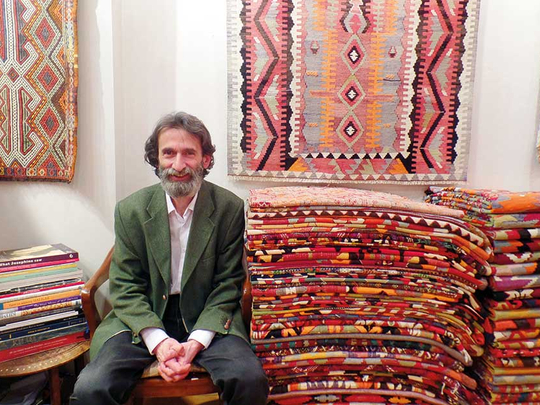
A carpet shop in Istanbul’s historic Grand Bazaar may not come across as a likely setting for finding solutions to major global challenges faced by humanity today, but my interview with kilim expert and dealer Hikmet Sirlak ended up going into topics far beyond the length of a traditional hand-woven carpet.
“As a civilisation, we are approaching very hard times,” he tells me. “We [have] accumulated so many problems in the last 10,000 years. In the beginning we didn’t know, but now we are paying for it. And for many vital questions we need answers. The key, I do not think, is in the past but somehow we have to learn from the past as to how we did get into trouble.”
One solution to modern society’s troubles can be found in the traditional carpet. “Kilim, since it is witness of so many ages and civilisations, it is a very important key,” he says. “This is why we need science, why kilim should be investigated and learnt without any paradigm, without any filter. For humans to survive to another century, we need to look back. Kilim is not the only thing but kilim is one of them. We have to go back to the most simple beginning and look at how we complicated it. Because somewhere we have done wrong.”
Over cups of Turkish coffee and tea, he narrated the story of kilim in Turkey and how he became mesmerised by the carpets. Sirlak has been employed at the kilim shop, Recep Karaduman, since 2001, although he started work in the carpet business much earlier, back in 1981.
The kilim business
Sirlak was born in Karaman, central Turkey, where he lived for five years before moving to Istanbul. When he was young, the Grand Bazaar was on his way to school. “The Grand Bazaar itself was a school, actually a university,” he says. “Not only the bazaar, the area around the bazaar — this is where trade still works in a primitive way.”
He started working in the kilim business during high school when he was 15 or 16 years old. “I was thinking what should I study, economics or psychology? So, I was even not sure what to study or to study or not. But I was doing this as a temporary job,” he recalls.
Once he got into the business, Sirlak found he couldn’t quit. He used to collect kilims and sell to the shops. He would travel to the Anatolian countryside to find carpets. He says it’s an urban legend that people go directly to the villagers to buy carpets. Instead, Hikmet went to people who collected old carpets.
The women who weaved the kilim worked in agriculture and looked after goats and sheep. During winter, there would be less work, so people did handicraft. “A kilim of, let’s say six square metres, they used to weave in one winter. If they had one extra, they would sell it.”
Today, there are still some people weaving kilims but the production is not enough to supply the market.
“In some village somewhere in some mountain, someone is weaving a kilim but the number of them is so limited. To find a rare antique rug is easier than [to find] a good new kilim,” he says.
One factor behind this decline is the number of young people who have left villages. “Turkey’s population is 80 million. A quarter of them live in Istanbul. And we have other big cities. And in the villages, there are no young people. And if there are some left weaving kilim, they [make] kilim for the market for export or for tourism.
Today, carpets are imported from countries such as Afghanistan, China or Pakistan. “They are designed by market specialists and the material is industrial material mostly. And the looms are also made of steel, not made by the villagers. So, it is a global work, or I can say collateral damage. They are still hand-woven though — that is the part where the hand touches the carpet but only that.”
Some years back he wrote a brochure titled “Kilim is body language” which became quite popular. If a passer-by looks through the window he likes to give them a copy. His clients don’t belong to a certain category. “Ninety-nine per cent of people passing here don’t care about us. They don’t listen to us, and they don’t understand what we write, what we talk. But the ones who understand, they say ‘This is my shop’.”
Who are his customers? “People say my clients are Spanish or my clients are rich or middle class. In the millennium, there is no such thing, you don’t have masses. You target individuals. So, my clients are not Spanish, Turkish, German, or whatever. There are people on earth who have, I can say, no nationality and not member of groups. [They] live as individuals.”
His customers are even not looking for kilims. “They are not after anything. They are just browsing around.”
Sometimes famous celebrities come to the shop but he doesn’t recognise them and his friends later tell him their identity. Sirlak doesn’t watch a lot of movies and doesn’t have a television at home. “To live in Istanbul and to have a TV is the most stupid thing,” he says. “I don’t want to talk sharp. Maybe TV is stupid all over the world. Imagine you live in this city and you have a television. Come on!”
On a visit to Istanbul, the Syrian-born Lebanese poet Adonis once came to his shop the day before he had won a prize. “I was drinking my first coffee [of the day], not really woken up, it was a rainy day. I looked. Adonis. I showed him some kilims. He didn’t buy anything. Then I said, ‘Aren’t you Adonis?’ He said ‘Yes’. And when he left, he must have thought, ‘Look at this country. I go into just a shop, and they know me. But in my country, they only know pop stars’.”
Matching the environment
People come to him and ask for kilims to match a certain environment, but the interesting thing about kilims, says Sirlak, is they don’t match with any place. Instead kilims match with conflict.
Most of the kilims in the shop are old, not antiques. They are from the beginning of the 20th century through to the 1960s and 1970s. “The criteria is that they are made by nomads or peasants for their own use out of natural material,” he says. “And designed by themselves. Not for the market.”
In general, the prices run between 6,000 (Dh5,567) to 7,000 Turkish lira, with the most expensive kilim is 50,000. “We have fixed prices, we don’t bargain. We have on all of them labels, we don’t push clients, we only show them. Then when they select we leave them alone in the shop, we go outside. They think by themselves. So, no sales tricks or whatever.”
Sirlak only buys carpets that make him cry when he sells them.
“I still cry after 35 years,” he says. “I cry after every kilim I sell. My friend takes picture of each kilim and the client. And I try not to see the picture again. I don’t want to see the picture again.” The picture is to remember the person who bought the kilim and isn’t published. I am shown a picture by Sirlak’s colleague of a female client from Italy who had bought a kilim the day before.
Every kilim has its own story. Sirlak has one very rare carpet which he keeps at home. It is a kilim made by a tribe called the Yuncu. “Yun means wool. It is like Sufi in Arabic. Sufi is wool.”
Has he met any Sufis in his kilim travels? “Not in the kilim travel. But nearly every carpet dealer is a low budget Sufi. A carpet dealer who has a lot of time to sit in the shop has nothing to do but think and has many people to talk to. They produce a lot of low-budget ideas. So, I call them Sufi.”
Kilims by the Yuncu tribe have a good reputation. “They use red and blue the best way and they nearly don’t use another colour. And their kilims are known and very expensive. But this piece is from that tribe with a very rare design, and very simple. And so it is the simplicity.”
In a corner of the shop where we are seated is a pile of books on carpets. I ask Sirlak if he likes to read a lot. “I don’t read a lot about carpets,” he says. “There is a problem in carpet literature where more than 90 per cent is science without reference. You see all those books? They are written by people who are wrong. If you do science, you give references. You cannot say ‘I heard it from this dealer, that villager.’ They are mostly like that.”
There is a lot more to a carpet than the product itself. Sirlak loves to read about science, not to learn, but to enjoy. “To enjoy, it has to be really sharp science where you see facts, references. This is what science about kilim lacks. They want to define, they want to find the result. You don’t find the result. For the last 35 years, I am in this [business], I am not an academic but I had so many facts. What I know about kilim. I don’t know, because you cannot know. You can know something but you cannot know kilim. It is the psychological history of human beings, of civilisation, recorded in one textile.”
Sirlak becomes philosophical.
“When we invented the wheel we didn’t know that we would create this traffic jam. So, I am not against inventing the wheel. I am not against science, development. But to see the future we should go back, roll back to the most primitive — what did we do in the beginning?”
Today the age-old tradition of carpet making is still kept alive by artists who, instead of painting, make kilims.
“Art in its most simple form, kilim and music are some of the few things from our past that is untouched and undestroyed. Covered with mud but it is still in there.”
As I wrap up the interview, I get a feeling there is still more to cover. “This kilim subject, even if you talk the whole day, there is always something missing,” he says.
Syed Hamad Ali is a writer based in London.












